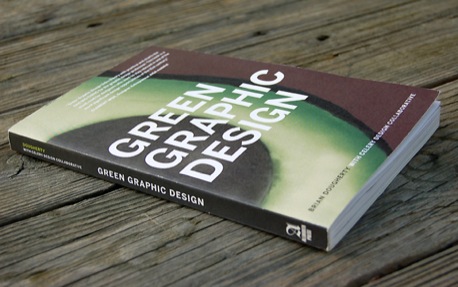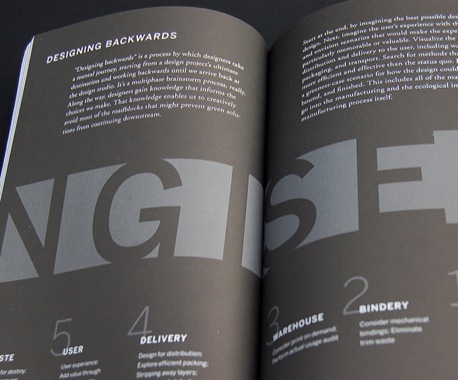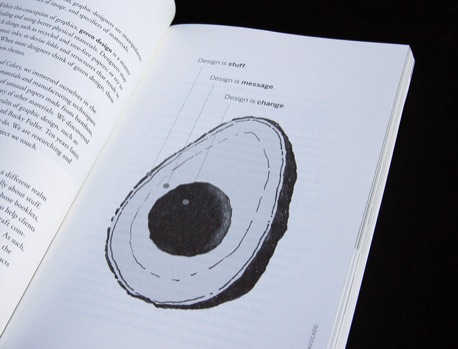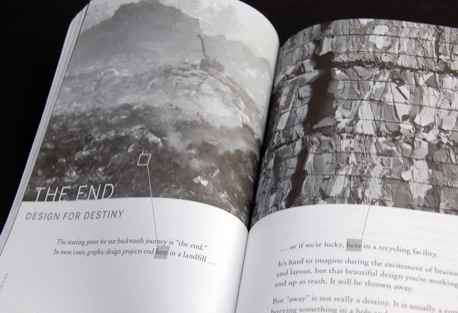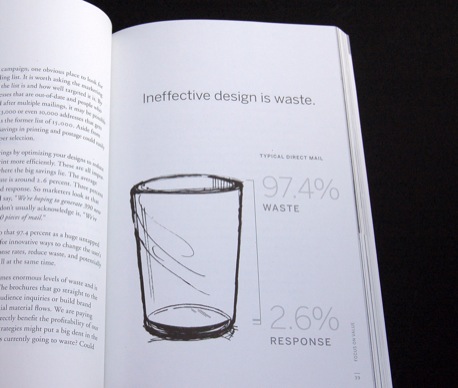Green Graphic Design
Review by Virginia Sasser
We know that sustainability is an urgent design issue, despite the fact that some of us are tired of mainstream “greenness” blanketing our consumer landscape with tree frogs and leaf icons. But are we as designers aware of all the realistic ecological options that exist in our field? Doing the right thing is tough, especially when clients and budgets are involved. Brian Dougherty’s book Green Graphic Design
Dougherty, a founding partner of Celery Design Collaborative, is a legitimate voice at the forefront of ecological communication and sustainable corporate design. Celery’s eco-friendly practices have been recognized by ID Magazine’s ID 40 list of influential design firms and by the AIGA Environmental Leadership Award. Their “designing backwards” and green branding philosophies pertain to all visual communicators who want to maintain a bearing on the industry’s momentum.
(Click to enlarge)
Dougherty gives a design-centered overview of well-traversed sustainable principles such as waste, value, and the market inevitability of green commodities. “The influence of design is increasing,” he says, asserting that graphic designers have an added responsibility to produce more sustainable work. Dougherty describes his concept of “green design as an avocado,” with “change” representing the vital core that sets it apart from the rest of the field.
(Click to enlarge)
But most of us know why green design is important. The resonant content is when Dougherty gets past the theoretical analogies and answers the lingering question of how. The heart of his book details a straightforward, systematic approach to alterations designers should make to their process, and they go well beyond the standard rhetoric about printing on recycled paper (though it has a great “Ecological Guide to Paper” in the back).
Dougherty’s argument revolves around fundamentally changing the way we think about design. He encourages better decision-making long before materials come into play. He calls it “designing backwards,” which considers the “destiny” of a design first. You start, he says, by figuring out a design’s terminating fate, such as litter, landfill, recycling plant, or compost heap, and then move backwards in the process. Considering the journey of a design step-by-step in reverse enables designers to plan for the “greenest case scenario,” and as Dougherty explains, “creatively avoid most of the roadblocks that might prevent green solutions from continuing downstream.”
The pragmatic guidelines encourage designers to critically assess and redefine their approach to projects through detailed scenario planning and forethought. Understanding the audience and outcome, using the right production and shipping methods for the job, talking to clients, responsible strategizing, and choosing the right ink and bindings are among the many factors the book considers. Case studies from Celery’s long history and other external projects illustrate Dougherty’s ideas. They range from Canada’s successful beer bottle take-back system to IDEO’s plantable seed-filled packaging for Pangea Organics. The addition of a glossary, resource list, and sustainability scorecard in the back make Green Graphic Design a convenient guide without the dryness of a typical reference book.
(Click to enlarge)
Dougherty’s insights also examine the corporate responsibilities and green branding that are revolutionizing our businesses. “It is important to remember that sustainability is not some vague, malleable notion. It is specific and measurable. It is also incredibly rare.”
The book warns of the dangers of greenwashing, such as exaggerated declarations from self-proclaimed eco-friendly brands. Dougherty encourages honest communication about a company’s environmental successes and challenges to facilitate the designer’s ability to create real solutions. “Transparency helps graphic designers craft communications with real substance. It takes design out of the role of cheerleading and places it into a role of change agent.”
Dougherty acknowledges that green design is a challenging but real option. “Ultimately, ‘sustainability’ is just a beginning,” he writes.
“We don’t want to sustain. We want to thrive. It is extremely important that we transform our communications systems to cause far less environmental damage. But being ‘less bad’ is not what motivates us. We are motivated by the exciting, creative opportunities that await us. We strive for the positive potential that designers can unleash – in our own practice, in the operations of our clients, and in the actions of the people who receive our messages.”
And they practice what they preach. The book itself was printed with low-VOC vegetable-based inks on 100 percent post-consumer recycled paper. The green design decision to make the majority of the book in one color does not sacrifice its visual appeal.
(Click to enlarge)
While full of clear and engaging detail, at times the book lacks straightforward organization. The chapter and sectional hierarchy is somewhat puzzling and makes navigating the content tricky. That aside, it maintains a pleasing design that supports the content. Dougherty’s writing is personable and encouraging. The information flow is relieved by large callouts, and the black and white visuals are attractive and unpretentious.
With Green Graphic Design designers will not only be well equipped to make more sustainable decisions on their future projects, but they will also know how to convey that conscientiousness to their clients and audiences. Dougherty successfully disentangles much of the abstract eco-information floating around today and reinvigorates a weary discussion with excellent, concrete examples.
Green Graphic Design By Brian Dougherty with Celery Design Collaborative is published by Allworth Press. You can buy it from Amazon (US



About the Reviewer
Virginia Sasser is a 2nd year student on the Graphic Design MFA program at MICA.


